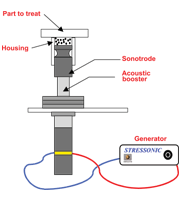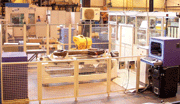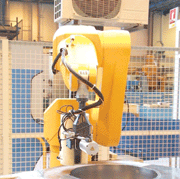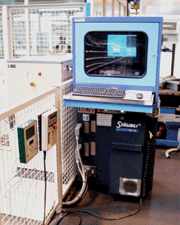E-Archive
Cover Page
in Vol. 4 - May Issue - Year 2003
Ultrasonic Shot Peening

STRESSONIC



Sonats, set up in 1993, first specialized in the control of parts’ behaviour during manufacturing or in operation, mainly through material health analysis (residual stresses). This allowed the French company to develop some competence in the diagnostic field. Then it quickly developed an innovating remedy to improve parts strength when subjected to fatigue. The ultrasonic shot peening process was introduced and patented by the company. The remedy profession was founded at Sonats in 1997. Qualification programmes were created for national and international users in the aviation industries (Airbus, Snecma, General Electric, Pratt & Whitney, MTU, Turbomeca,…), in the energy industries (Framatome, Comex Nucléaire, EdF, Westinghouse, Alstom, Toshiba,…) and in the automotive industries (Toyota, Montupet, Volvo Cars,…). By doing so, those companies were allowed to integrate a new technology.
Shot peening is a cold working process, through the bombardment of metallic balls called “ shots ” onto the surface to be treated. The aim is to improve the fatigue strength of certain parts thanks to compressive stresses induced by the shot peening.
In the case of ultrasonic shot peening, an acoustic system, made of a piezoelectric transducer and a booster, vibrates a sonotrode connected to a housing containing shot to blast onto the part (see sketch below). The vibration takes place at 20 kHz, with an amplitude of up to 200 µm.
This process offers several advantages compared to the conventional shot peening such as the low cost of shot, treatment reproducibility, improvement of part roughness and equipment compactness.
The parameters to check in order to control the induction effects on the part are:
- treatment time
- mass of balls in the housing
- sonotrode vibration amplitude
- speed of movement part/sonotrode
Those parameters are computer supervised and allow the reproducibility as well as the traceability of the process.
An application for Diesel Engines
The SEMT Pielstick company (Saint-Nazaire, France), which has been working with Sonats for a few years, was interested in applying the Stressonic® process to some connecting rods intended for diesel engines for naval and energy fields. The goal was to increase productivity and to reduce cost.
First, the Stressonic® parameters were perfected to optimize the parts’ treatment. A series of validation parts were treated for their implementation on engine benches in order to perform some endurance tests. Those ones allowed us to validate treatment ranges and to launch the equipment manufacturing.
The concept developed by the French manufacturer had to offer a total reproducibility and the equipment was to be operated by a non-specialist in shot peening. Furthermore the machine had to have the flexibility to treat several different parts, should be user-friendly and reliable.
To fulfil all those criteria Sonats decided to develop the concept of a Stressonic® "head set" to be installed on a 6 axis Stäubli RX130 L robot.
The RX130 L has been chosen for this specific application because of its performances in trajectories follow-up (speed, position, orientation). To operate in the requested surrounding, the robot was to fulfill protection category IP 65.
The robot "learns" the initial trajectory by teaching. The recognition of the part is made through laser triangulation. The program chosen by the operator can only be executed if the computer finds a match between the program selected and the part to be treated. The process starts by a plunge of the head into the bore. A sort of "drawer" will open, which contains the shot (several grams).
Then the treatment is dynamically realized in the rod. The Stressonic® process parameters are followed in real time. Any malfunction will be identified, registered and analysed by the on-board supervision system. That insures that all parts of the same reference are identically treated.
The advantage of the concept for SEMT Pielstick was the integration of the technology in production line and the polyvalency of this concept. Cleanliness was also a factor. There is no need to clean the part after treatment since there is no shot lost in the lubrication holes requiring the dismantling and reassembly of the rod’s head as in conventional shot peening.
Of course, this project would never have succeeded without the support of SEMT Pielstick and its will to integrate a new technology on one side, and the help of Stäubli –Robot Division - on the other side.
Thanks to this project, Sonats demonstrated its ability to apply the new Stressonic® technology in a new field, which has great potential for such similar applications.
For information:
Sonats
Bat. Cap Sud
1, rue Ile Mace - CP2017
44406 Reze Cedex
Tel: +33.2.51 700494
Fax: +33.2.51. 700583
E-mail: sonats@sonats.com
https://sonats-et.com/en



























